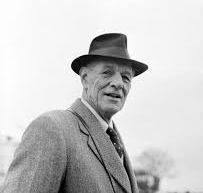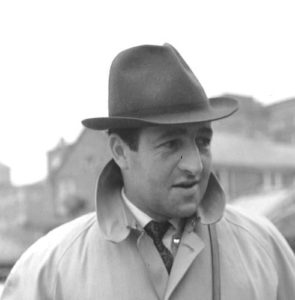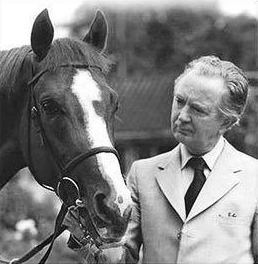Three trainers who dominated the latter half of the 20th century
Noel Murless, Dick Hern & Vincent O’Brien
View landscape on mobile phones
 Sir Charles Francis Noel Murless (1910-1987), rode first as an amateur and then as a professional jump jockey for Martin Hartigan at Weyhill. Thereafter, he worked as assistant trainer to Hubert Hartigan (Martin’s brother), in Ireland. From 1935, Murless trained successfully from Hambleton, near Thirsk, albeit with horses of limited ability. However, on the retirement of Fred Darling at the close of the 1947 Flat season, Murless took over Beckhampton, retaining the association with Gordon Richards. The following year he was Champion Trainer for the first time and topped the lists a further eight times in his career.
Sir Charles Francis Noel Murless (1910-1987), rode first as an amateur and then as a professional jump jockey for Martin Hartigan at Weyhill. Thereafter, he worked as assistant trainer to Hubert Hartigan (Martin’s brother), in Ireland. From 1935, Murless trained successfully from Hambleton, near Thirsk, albeit with horses of limited ability. However, on the retirement of Fred Darling at the close of the 1947 Flat season, Murless took over Beckhampton, retaining the association with Gordon Richards. The following year he was Champion Trainer for the first time and topped the lists a further eight times in his career.
In 1952, Murless moved to Warren House at Newmarket, and when Sir Gordon retired two years later, Murless appointed the teenage Lester Piggott as the new stable jockey. Murless (like Fred Darling) trained 19 Classic winners. He had five winners of the Oaks: Carrozza (1957), Petite Etoile (1959), Lupe (1970), Altesse Royale (1971) and Mysterious (1973). He also trained three winners of the Derby: Crepello (1957), St Paddy (1960) and Royal Palace (1967). The historian Roger Mortimer wrote of him: “Murless is a lean, lined, worried looking man….and though friendly and courteous, it is difficult to visualise any sort of party of which he could possibly be the life and soul.”
 William Richard ‘Dick’ Hern (1921-2002), was born in Somerset and, after serving in the North Irish Horse in World War II, held the position of coach to the British gold-medal winning equestrian team in the 1948 Olympics. In 1957, having worked as assistant trainer to Michael Pope, he took over the Lagrange Stable at Newmarket.
William Richard ‘Dick’ Hern (1921-2002), was born in Somerset and, after serving in the North Irish Horse in World War II, held the position of coach to the British gold-medal winning equestrian team in the 1948 Olympics. In 1957, having worked as assistant trainer to Michael Pope, he took over the Lagrange Stable at Newmarket.
Champion Trainer four times, he trained the winners of 16 Classic races including Brigadier Gerard, winner of the 1971 Two Thousand Guineas and rated the greatest winner of that Classic in the 20th century. Hern also trained – three winners of the Oaks – Dunfermline (1977), Bireme (1980) and Sun Princess (1983) and three Derby winners: Troy (1979), Henbit (1980) and Nashwan (1989). Strong in the face of adversity, Hern continued to train after a hunting accident in 1984 that left him confined to a wheelchair. Furthermore, in 1988, soon after undergoing major heart surgery he learned that William Hastings-Bass (later Lord Huntingdon), was to replace him as resident trainer at the Queen’s West Ilsley Stables. However, a compromise was later agreed, enabling Hern to share the stable with Hastings-Bass for a year, before moving to Sheikh Hamdan Al Maktoum’s Kingwood House Stables in Lambourn. And it was from that stable that Hern turned out Nashwan to win the Derby.
 Vincent O’Brien (1917-2009), is widely regarded as the greatest trainer of the 20th century, both on the Flat and over the jumps. His 16 British Classic victories included, two winners of the Oaks – Long Look (1965) and Valoris (1966), and six winners of the Derby, notably Sir Ivor (1968) and Nijinsky (1970 Triple Crown). Over the jumps, he trained the winners of three consecutive Grand Nationals between 1953 and 1955 – Early Mist, Royal Tan and Quare Times – four Cheltenham Gold Cups and three Champion Hurdles.
Vincent O’Brien (1917-2009), is widely regarded as the greatest trainer of the 20th century, both on the Flat and over the jumps. His 16 British Classic victories included, two winners of the Oaks – Long Look (1965) and Valoris (1966), and six winners of the Derby, notably Sir Ivor (1968) and Nijinsky (1970 Triple Crown). Over the jumps, he trained the winners of three consecutive Grand Nationals between 1953 and 1955 – Early Mist, Royal Tan and Quare Times – four Cheltenham Gold Cups and three Champion Hurdles.
Born in 1917, near Churchtown, Co. Cork, Michael Vincent O’Brien supervised the training of his father’s small string at Clashganniff from the late 1930’s and, a year after his father’s death in 1943, he took out a licence to train. In 1951, the year he married Jacqueline Witternoom from Perth, Australia, he moved to Ballydoyle, Cashel, Co. Tipperary, where he developed a training establishment par excellence.
In the mid-1970’s, O’Brien formed a partnership with Robert Sangster and John Magnier. Together, they purchased yearlings with good pedigrees, many by Northern Dancer, turned them into champions and stood them at Coolmore Stud. Lester Piggott usually rode O’Brien’s runners in England.
A man of quiet, gentle genius, Vincent O’Brien retired from training in 1994. His first Classic winner in Britain was Ballymoss (1957 St Leger) and his last, El Gran Senor (1984 Two Thousand Guineas). In the 1984 Derby, El Gran Senor was beaten a short head by Secreto, trained by Vincent’s son David.
For more History of the Turf check out Michael’s new list of BOOKS FOR SALE